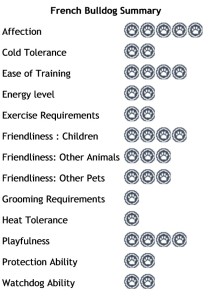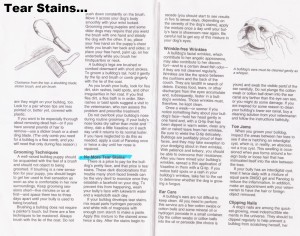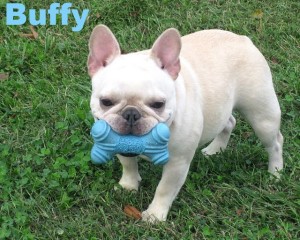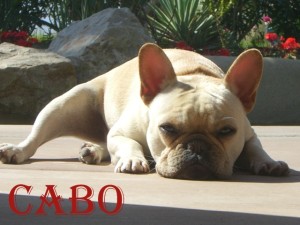 Care and Cautions about your French Bulldog Puppy:
Care and Cautions about your French Bulldog Puppy:
Here are some things you should know before you consider purchasing a French Bulldog.
 Feeding:
Feeding:
A puppy requires a high quality diet specifically formulated for growth. In general, feed puppies an amount they can comfortably consume within 5-10 minutes. Feed three times a day until your French bulldogs is 6 months of age. As they continue to grow, feed twice a day up to adulthood. Then gradually switch them to an adult ration.
Allergies:
French bulldogs can have allergies which are an abnormal immune reaction by the body to everyday substances. These substances, called allergens, can be pollen molds, house dust, hair, wool carpet or clothing, feathers, insects (fleas), food and chemicals. Special skin tests may be required to determine the type of dermatitis present. Proper diagnosis is important for proper treatment.
Allergies can occur at any age. The common signs of allergy are: continuous licking and chewing of the foot, rubbing the face, trying to rub the ears (inflammation of the ear), and watery eyes.
The four major categories of allergy are flea allergy, airborne allergy, food allergy, and contact allergy. Allergies are not covered under the one year health guarantee.
 Ear cleaning & Tear stains:
Ear cleaning & Tear stains:
A French bulldog’s ear canals are longer than ours and typically produce more wax. They tend to get infected more often. To reduce the chance of ear infection beginning clean them on a regular basis with the cleansing agent prescribed by the vet.
Warning: Do not use Q-Tips in the canal as you may pack debris into the canal and damage the ear drum. Q-Tips may be used to clean the folds of the ear flap.
Please see picture below for great formula for tear stain removal.
Exercise:
 French Bulldogs need room for growing, particularly the hips and their articulations.
French Bulldogs need room for growing, particularly the hips and their articulations.
Things to Avoid with this breed especially while the French bulldog is young: forced jumping exercises, stairs, jumping up/down on beds or furniture because vertical movements can give increased pressure on the surfaces of the cartilage of the articulations and consecutively hypersecretion of articular fluid and damage of the intra-articular cartilage. Swollen and painful articulations could follow, with deformation of the position of the legs. French Bulldogs may be considered as young, until they are around 18 months. However, we recommend you teach your Frenchie not to take several steps at a time or even better gate steps if they show that they love to jump. Also if you want to have your French bulldog to join you on furniture or sleep with you teach them to use steps to get up and down. We do this just as a precaution. It is always better to be safe than sorry if your baby tears or blows a hip or joint due to excessive pressure.
Heat:
French bulldogs are very sensitive to overheating. Never leave them alone in a car. Avoid exercise during the hot summer period. If you wouldn’t walk outside barefooted on the pavement then it is too hot.If your dog shows signs of overheating, wipe him with wet, fresh towels, fan him and give him some fresh water.
Genetic disease predisposition:
Luxating Patella, Stenotic nares, hernias, Elongated soft palate, hip dysplasia, Hemivertibrae, vertebrae are just a few things that plague our precious breed. Being a Brady Cephalic breed, we have to stay cooled because of that short face. The French bulldog, does not do well as a “yard only” dog, they will quickly over heat and could have a heat stroke.
 Hips:
Hips:
In general, most of the French bulldogs hips are fine. Bitches, X-rayed in order to see how many puppies, show small opening of the pelvic ring, which means that there is not room enough for the pups to come out. Some bitches sometimes have problems because of their pelvic ligaments being more rigid and less relaxed than in young bitches and c-sections are recommended.
Hip Dysplasia denotes an abnormal development of the hip joint(s). Most osteo-arthritis of the hip can be traced to some form of hip dysplasia. Vascular changes in the bony structures of the hip at least, but whether the causes of these changes are pre-natal or post-natal is not clear.
In general, it is thought that hip dysplasia is hereditary in the dog, although opinions vary (due to a recessive factor or due to a dominant factor with irregular penentrance.) Comparing the spread of hip dysplasia in many breeds, the French bulldogs doing quite well. With careful breeding and hoping that the breed will not become a fashion breed, the French bulldog has a healthy future.
SEE ABOVE ON JUMPING LIMITATIONS WITH THIS BREED.
The Look of a French Bulldog:
French Bulldogs are on the small side. They have compact, big-boned, muscular frames with smooth coats and “bat-like” ears. Their square heads have rounded skulls, broad muzzles and black noses. Their eyes are small, dark and set low on the face, just above the muzzle. French bulldogs have strong necks, full chests and short, stocky legs. Their tails are short and thick (some have the no tail look), and their soft coats come in solids or combinations of brindle, fawn and white. Overall, French Bulldogs look alert, friendly and sturdy. Trademark traits also include cuddly, fearless, loving & protective.
Ideal Human Companions:
- Singles
- Retirees
- Active, sporty types
- Families
- City dwellers
- You name it
The French Bulldog’s motto is “Love the one you’re with”. The Frenchie is adaptable to any home environment, as long as it has air conditioning.
